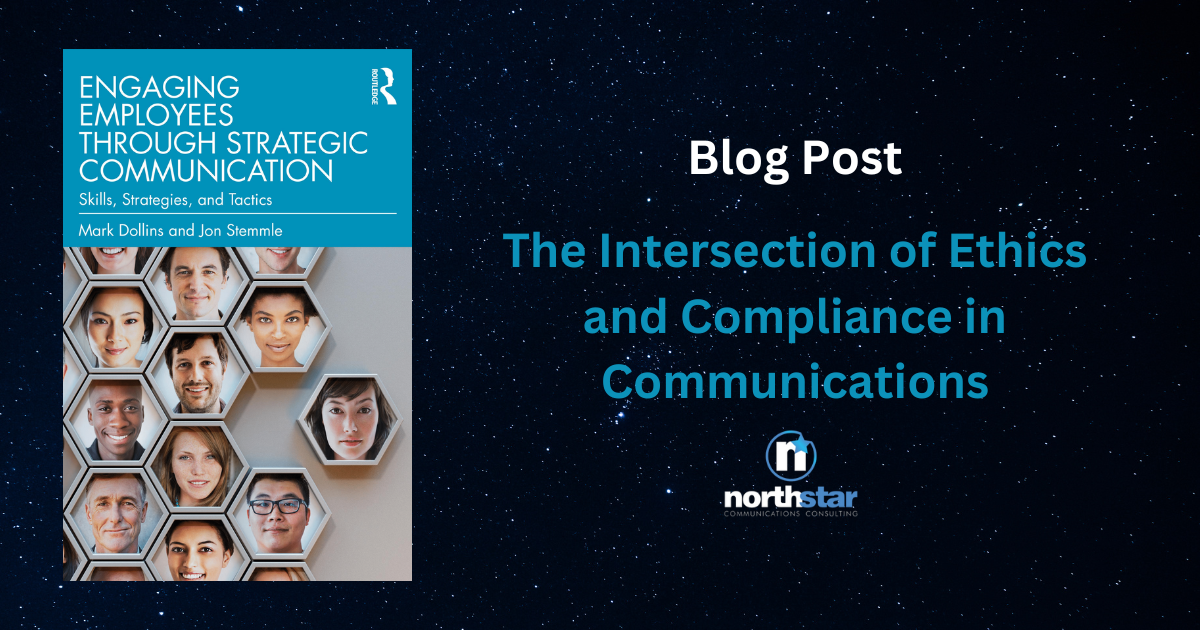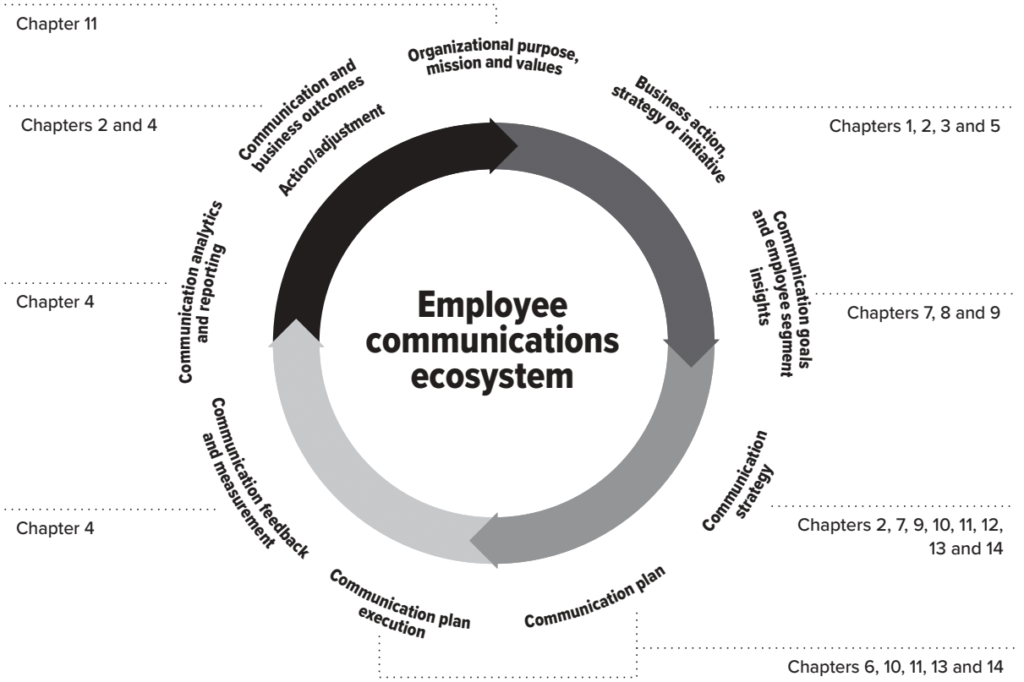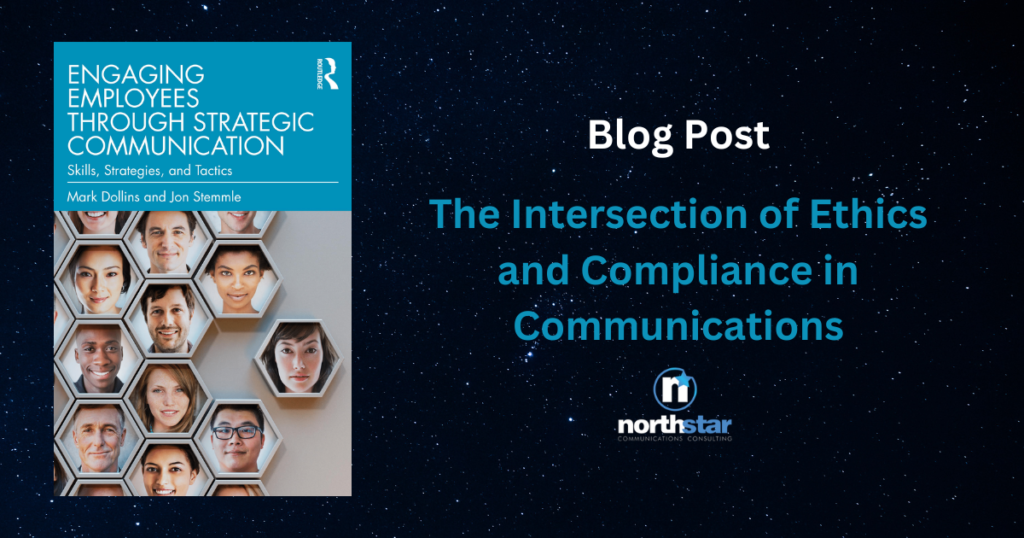
This blog post briefly summarizes chapter six of the book Engaging Employees Through Strategic Communication by Mark Dollins and Jon Stemmle. Visit engage-employees.com to grab your copy today.
Ethics and Compliance
If you were to ask people about the ethics in the field of communication, some might cynically say there aren’t any. For many on the outside, communication can be seen as a profession that fosters pop-culture depictions of spin control, gerrymandering of information and bold-face lies. While that may be an attractive trope in the entertainment industry, the truth in the majority of cases is far from what viewers see on television shows like House of Cards. It does, however, call into question the practice of ethics in communicating—both externally and internally.
For example, how do employee communicators—when asked to communicate good news about bonuses to employees one week, yet knowing about upcoming layoffs—ethically communicate the positives while ignoring pending, confidential negatives? It’s a scenario faced by many internal communication specialists and it puts the issue of ethics squarely in the bullseye.
According to Patrick Plaisance in his book Media Ethics: Key principles for responsible practice, ethics is the “inquiry concerned with the process of finding rational justifications for our actions when the values that we hold come into conflict.” The definition is slightly altered when placed in the context of public relations. Patricia Parsons in Ethics in Public Relations defines ethics as “the application of knowledge, understanding and reason, to questions of right or wrong behavior in the professional practice of public relations.”
This latter definition fits the world of employee communication if we modify the setting (the corporate world) and the audience (employees). However, these concepts were first formed long ago. In fact, codes of ethics were established almost from the beginnings of modern public relations around the turn of the 20th century. In many cases, ethics in communicating is more broadly defined under the umbrella of public relations, but the reality is that internal communicators are bound by the same constructs.
The foundation of the ethical codes was created by Ivy Ledbetter Lee around 1905 during a time when he was representing coal mine owners who were dealing with an employee strike. Lee was a pioneer of a new tool, the press release, which he decided to use in this case to provide the newspapers covering the strike with daily informational updates in a printed form. These updates were seen as corporate publicity or advertisements by the reporters of the day, and Lee’s efforts were met with hostility. In order to fight these accusations, Lee issued what he called a “Declaration of Principles” explaining his work and intent stating:
This is not a secret press bureau. All our work is done in the open. We aim to supply news. This is not an advertising agency; if you think any of our matters ought properly to go to your business office, do not use it. Our matter is accurate. Further details on any subject treated will be supplied promptly, and any editor will be assisted most carefully in verifying directly any statement of fact. Upon inquiry, full information will be given to any editor concerning those on whose behalf an article is sent out. In brief, our plan is frankly, and openly, on behalf of business concerns and public institutions, to supply the press and public of the United States prompt and accurate information concerning subjects which it is of value and interest to the public to know about. Corporations and public institutions give out much information in which the news point is lost to view. Nevertheless, it is quite as important to the public to have this news as it is to the establishments themselves to give it currency. I send out only matter every detail of which I am willing to assist any editor in verifying for himself. I am always at your service for the public of enabling you to obtain more complete information concerning any of the subjects brought forward in my copy.
For communication professionals, there are specific guidelines in place provided by local, regional or global trade organizations supporting communicators as led by groups such as the International Association of Business Communicators (IABC), the Global Alliance for Public Relations and Communications Management and the Public Relations Society of America (PRSA). Specifically related to IABC, when members are facing difficult issues, IABC’s Ethics Committee serves as a global resource. The Ethics Committee offers advice and assistance to communicators regarding specific ethical situations and assists with professional development activities dealing with ethics. Each member agrees to strict conflict of interest and confidentiality guidelines.
Along with the concept of presenting accurate, honest information to the public and internal stakeholders, there are other commonalities related to the ethics of the profession between these organizations, including protecting confidential information, not representing conflicting or competing interests and supporting the ideals of free expression.
While these ethical guidelines provide a solid framework for the profession of employee communication, ethics are not that simple. Along with these professional organizations, companies may have their own ethical policies, and each individual has unwritten ethical rules that are determined by their families, peers and experiences they go through in life. In general, ethical guidelines should conform with accepted societal normal and cultural values.
Are you interested in learning more? Pick up a copy of Engaging Employees Through Strategic Communication for the full chapter to learn about the Foundations of Ethical Decisions in Employee Communication.
Get Your Copy Of The Engaging Employees Through Strategic Communication Book Or Contact North Star Communications Today

The diagram above shows the different topics covered in the book. Take advantage of the opportunity to enhance your organizational communication strategy and engage your employees effectively by getting your hands on the highly recommended book, Engaging Employees Through Strategic Communication by Mark Dollins and Jon Stemmle. Piqued your curiosity? Want to know why change communications, Block Chain, Artificial Intelligence and employee activism will shape our near-term future? Visit engage-employees.com to grab your copy today.
If you’re looking for expert guidance in implementing change communications, talent development, and coaching in your organization, look no further than North Star Communications Consulting. Contact us today to schedule a free consultation and take the first step toward transforming your organizational communication approach.


